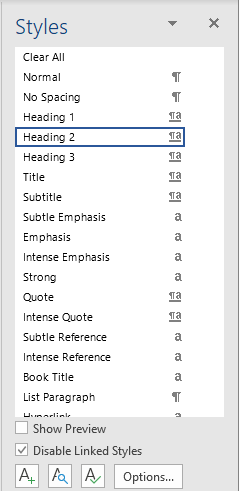Here are six ways to check what Word style your text is in (the last two are my favourites):
Six ways to see your Word style
Quick Styles gallery
Look at your Home ribbon to the right of the paragraph formatting area. Depending on the width you have on your screen, you’ll see the top row of the Quick Styles gallery. (Click the more arrow on the right (labelled 1) to see all the styles currently in the Quick Styles gallery). On a narrower screen, you’ll see a Styles button.

The current style is highlighted – above it is Heading 1.
Styles pane
Looking again at the Styles section of your Home ribbon. On a PC you can click the dialog box arrow on the bottom right (2) to see the Styles pane (or with the keyboard shortcut Alt+Ctrl+Shift+S). On a Mac, click the Styles Pane button on the ribbon (or Cmd+Opt_Shift+S).
In the Styles pane shown below left, Heading 2 is selected because the cursor is sitting in text that is Heading 2 style. On the right is the same pane but with ‘Show Preview’ selected – now the styles are shown as they appear when in use. The Mac’s Style pane look a bit different, and by default shows formatting.


Style Inspector pop-up
If you click the button circled at the bottom of the right-hand Styles pane above, the Style Inspector pop-up window will open. This gives you information about the current style.

Word for Mac doesn’t have this as a separate feature, but the top of the Styles Pane gives similar information about the current style and any manual formatting applied.
Apply Styles pop-up (PC)
You can choose ‘Apply Styles…’ from the bottom of the Quick Style Gallery (or use the keyboard shortcut Ctrl+Shift+S). This will show the Apply Styles pop-up window, which shows the current style and lets you select a different one.

Draft view
An easy way to scan long sections of a document for styles is to change to Draft view (View > Draft).
First, though, make sure you have set the Style Area pane width in Options to be something greater than 0 (e.g. 1.5 cm), as below.

Now when you look at your document in Draft view, the Paragraph styles are visible in the pane on the left, like here. It’s much quicker than clicking each line or paragraph individually when you want to check many styles at once.

A quick scan can be very revealing: some documents contain a multitude of styles (often more than is useful) while other documents are all in Normal style but formatted manually.
Quick Access Toolbar (PC)
A final way to view the current style (where the cursor is) is the easiest because it is always visible without needing to click or scroll. That is to add a box that shows the current style to your Quick Access Toolbar. (Although you can customise the Quick Access Toolbar in a Mac, the Style option is not available, so this is another PC-only feature.)
The Quick Access Toolbar is the very top bar of your window in Word. By default it has just a few commands on it, but you can customise it.
To add the Style box to the Quick Access Toolbar (PC):
- Go to File > Options
- Choose ‘Quick Access Toolbar’ in the left-hand column.
- In ‘Choose commands from’ select ‘Commands Not in the Ribbon’.
- In the list of commands, select ‘Style’.
- Click Add >>
- Use the up and down arrows on the right to move the Style entry up (left on the toolbar) or down (right).

Now you can see your current style in the Quick Access Toolbar without moving or clicking your mouse.

I first discovered this great tip from editor Hilary Cadman, and she has some more tips as well on her site.
Clicking the arrow to the right of the style name shows you the Style dropdown list, which is another way of selecting alternative styles.

Summary
Keep on top of your styles by adding the Style box to your Quick Access Toolbar (if you’re on a PC). And remember that you can quickly scan styles in Draft view.
What next?
Read more about what Word Styles are and how to use them. I’ll be adding tips on using Word styles for purposes beyond formatting your document soon.
See more tips and tricks. Tips on Word Styles are gathered in this collection.

Leave a comment